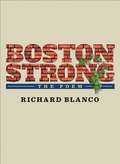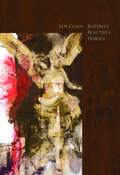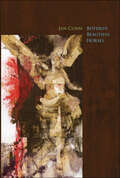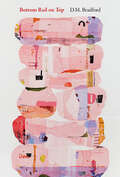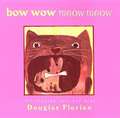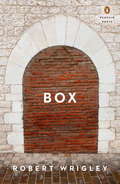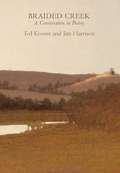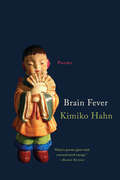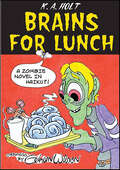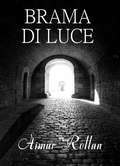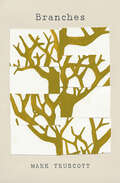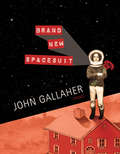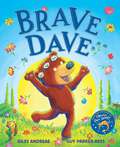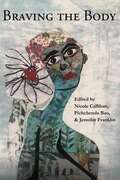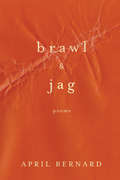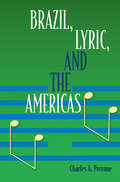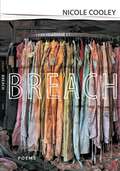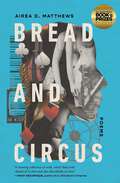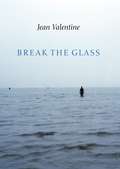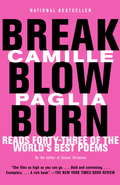- Table View
- List View
Boston Strong: The Poem
by Richard BlancoBoston Strong is a commemorative chapbook that beautifully reproduces Richard Blanco’s poignant poem presented May 30, 2013 at the benefit concert to help the people most affected by the tragic events that occured on April 15, 2013 during the Boston Marathon. The net proceeds from the sale of this book benefit The One Fund Boston. The One Fund Boston was established through the generosity of businesses, foundations, and individual donors. The Victim Relief Fund of The One Fund Boston will be used to assist those families of the victims who were killed and the victims who were most seriously affected as a result of the tragic events during the Boston Marathon on April 15, 2013, and related events on April 18 and April 19.
Botero's Beautiful Horses
by Jan Conn“Do we want love / each and every day of our lives?” Jan Conn asks in a poem called “Michoacán.” “You bet your ass,” she answers. The poems of Botero’s Beautiful Horses are charged with otherness, bright with the exhilaration and danger of transformation. Many are descriptions of surrealist canvases, astonishingly kinetic narratives composed by looking hard at unusual pictures, the artists’ writings and their circumstances – and letting them speak for themselves. The book becomes a journey away from the familiar into other cultures, especially Latin American. Poem after poem gathers a sense of inner as well as outward journey away from a “perilous childhood” into a wide world rich and strange with a recurrent underworld motif of darkness, blackness. But what a black! Rich and various, life as if viewed in the “obsidian mirrors the Aztecs fashioned from the dark.
Botero's Beautiful Horses
by Jan Conn“Do we want love / each and every day of our lives?” Jan Conn asks in a poem called “Michoacán.” “You bet your ass,” she answers. The poems of Botero’s Beautiful Horses are charged with otherness, bright with the exhilaration and danger of transformation. Many are descriptions of surrealist canvases, astonishingly kinetic narratives composed by looking hard at unusual pictures, the artists’ writings and their circumstances – and letting them speak for themselves. The book becomes a journey away from the familiar into other cultures, especially Latin American. Poem after poem gathers a sense of inner as well as outward journey away from a “perilous childhood” into a wide world rich and strange with a recurrent underworld motif of darkness, blackness. But what a black! Rich and various, life as if viewed in the “obsidian mirrors the Aztecs fashioned from the dark.
Bottom Rail on Top
by D. M. BradfordA rolling call and response between antebellum Black history and the present that mediates it. Somewhere in the cut between Harriet Jacobs and surveillance, Southampton and sneaker game, Lake Providence and the supply chain, Bottom Rail on Top sets off a mediation between the complications of legacy and selfhood. In a kind of archives-powered unmooring of the linear progress story, award-winning poet D.M. Bradford fragments and recomposes American histories of antebellum Black life and emancipation, and stages the action in tandem with the matter of his own life. Amidst echoes and complicities, roots and flights, lineage and mastery, it's a story of stories told in knots and asides, held together with paper trails, curiosities, and hooks — a study that doesn't end.
Bow Wow Meow Meow
by Douglas FlorianIt's rhyming cats and dogs in Douglas Florian's furrr-ocious collection of twenty-one original poems and paintings about our favorite animal friends. From barking Chihuahuas and pointing pointers to leaping leopards and purring Persians, here is a canine and feline compendium certain to haveeveryonebarking for joy.
Bow Wow Meow Meow: It's Rhyming Cats and Dogs
by Douglas FlorianFrom the Book Jacket: It's rhyming cats and dogs in Douglas Florian's fur-ocous collection of twenty-one of original poems and paintings about our favorite animal friends. From the barking Chihuahuas and pointing pointers to leaping leopards and purring Persians, here us a canine and feline compendium certain to have everyone barking for joy.
Box
by Robert WrigleyA powerful new collection from an acclaimed, award-winning poetWith nine previously published collections of poetry, Robert Wrigley has become one of his generation's most accomplished poets, renowned for his irony, power, and lucid style and for his ability to fuse narrative and lyrical impulses.Wrigley's tenth collection, Box, is a book of poems obsessed with human containment, with the way people are contained or confined—by time, mortality, technology, identity, culture, and history—in almost everything they are and everything they do. Even the body, even the poem itself, is in this regard a kind of self-containing crate, in which the human being, perhaps the human spirit, is shipped into the world at large. But Box is also a book obsessed with escape from containment, and escape comes from dreams, from deep awareness, from contemplation, from love, and above all, as Wallace Stevens insisted, from "the imagination pressing back against the pressure of reality." The poems in Box aim to do nothing less than "help people live their lives," as Stevens put it.From the Trade Paperback edition.
Braided Creek
by Ted Kooser Jim HarrisonBraided Creek contains more than 300 poems exchanged in this longstanding correspondence. Wise, wry, and penetrating, the poems touch upon numerous subjects, from the natural world to the nature of time. Harrison and Kooser decided to remain silent over who wrote which poem, allowing their voices, ideas, and images to swirl and merge into this remarkable suite of lyrics.Each time I go outside the worldis different. This has happened all my life. *The moon put her handover my mouth and told meto shut up and watch.*A nephew rubs the sore feetof his aunt,and the rope that lifts us all toward gracecreaks on the pulley.*Under the storyteller's hatare many heads, all troubled.Jim Harrison, one of America's best-loved writers, is author of two dozen books of poetry, fiction, essays, food criticism, and memoir. He is best known for a collection of novellas, Legends of the Fall, and the epic novel Dalva. He lives in western Montana and southern Arizona.Ted Kooser is the author of eight collections of poetry and a prose memoir. His poetry appears regularly in The Atlantic Monthly, The New Yorker, Poetry, and The Nation. He lives in Nebraska.
Brain Fever: Poems
by Kimiko HahnRooted in traditional Japanese aesthetics and meditations on contemporary neuroscience, a stunning new volume from an essential American poet. Acclaimed as "one of the most fascinating female poets of our time" (BOMB), Kimiko Hahn is a shape-shifter, a poet who seeks novel forms for her utterly original subject matter and "stands as a welcome voice of experimentation and passion" (Bloomsbury Review). In Brain Fever, Hahn integrates the recent findings of science, ancient Japanese aesthetics, and observations from her life as a woman, wife, mother, daughter, and artist. Rooted in meditations on contemporary neuroscience, Brain Fever takes as its subject the mysteries of the human mind--the nature of dreams and memories, the possibly illusory nature of linear time, the complexity of conveying love to a child. In one poem, "A Bowl of Spaghetti," she cites a comparison that researchers draw between unraveling "the millions of miles of wires in the [human] brain" and "untangling a bowl of spaghetti," and thus she untangles a memory of her own: "I have an old photo: Rei in her high chair intently / picking out each strand to mash in her mouth. // Was she two? Was that sailor dress from mother? / Did I cook that sauce from scratch? If so, there was a carrot in the pot." Equally inspired by Sei Shonagon's tenth-century Pillow Book and the latest findings of cognitive research, Brain Fever is a thrilling blend of the timely and the timeless.
Brains for Lunch: A Zombie Novel in Haiku?!
by K. A. HoltThe difference being that this middle school novel is written entirely in Haiku. Loeb, its zombie protagonist has a problem: the object of his affection, Siobhan, is a lifer (i.e. human). What to do? In scenes set around a lunch table (the menu: brains) and around the school, eyes roll and jaws drop (literally). Also featured in the cast of characters is Carl, a chupacabra (bloodsucking critter) and Mrs. Fincher, a sympathetic and seductive librarian.
Brama di Luce
by Valeria Bragante Aimar RollanPer i Sufiti non c’è castigo peggiore che provare nostalgia, sapendo di essere separati dalla fonte, né maggiore ricompensa che sentirsi uniti ad essa. Così, l’emozione che predomina in quest’opera è la nostalgia, ed il conseguente desiderio di liberarsi da essa e fondersi con l’Unità. Questa è la storia di una caduta, di una perdita, di un recupero e di una ascensione. È la storia di una ricerca della luce dall’oscurità più profonda. È scritta in prosa poetica, con breve frammenti indipendenti tra loro, che si possono leggere in modo isolato ma che mantengono una certa coesione, dato che ogni frammento porta con sé, o brama, un po’più di luce del precedente. Parla di un uomo che ha perduto la propria luce, ma che conserva dentro di sé un lieve scintillio del ricordo di essa. Questa fugacità tortura la sua mente e gli fa intraprendere un cammino di ascensione per recuperare un tesoro tanto prezioso. Passa attraverso tutte le fasi di depressione, tristezza e malinconia, crogiolandosi nella propria perdita. Nelle fasi iniziali identifica questa luce perduta con l’amore di una donna, con l’amore di molte donne che per lui sono una, e l’origine della sua malinconia è la perdita di questo amore. Man mano che il suo tormento avanza, riconosce che questa luce desiderata appartiene a qualcosa di più sottile e profondo, al regno della sua anima … Riconosce che questo dolore emozionale proviene dal sentirsi separato dalla fonte primordiale. Questa opera è scritta con un linguaggio malinconico, ma sullo sfondo vuole trasmettere bellezza, speranza ed allegria.
Branches
by Mark TruscottWinner of the 2020 Nelson Ball PrizeCareful attention reveals that, even in moments that seem insignificant, our minds are constantly navigating disjunctions among registers of experience. Our intellect silently reminds our eyes that the car that appears to be moving between leaves is actually behind them and much larger. The sound of the vacuum cleaner in the next room is noise to be ignored. The phrase that arises in mind belongs to a conversation earlier in the day. Clear thinking demands that these navigations remain unconscious. But what if they're meaningful, or productive, in themselves? What if they're necessary to help us find a more meaningful place in the world? Branches explores these questions.
Brand New Spacesuit (American Poets Continuum #179)
by John GallaherIn Brand New Spacesuit, John Gallaher writes with honesty, humor, and tenderness about caring for his aging parents. These poems offer snapshots of the poet’s memories of his adoption and childhood, his father’s heart attacks, his mother’s progressing Alzheimer’s disease and stroke, raising his own children, and his reflections on the complex mysteries of the universe within everyday moments. With exquisite attention to detail, Gallaher captures the losses, anxieties, and possibilities that come with caring for one another.
Brats
by X. J. KennedyThis is a book of short poems about mischievous children getting into all sorts of trouble, many times with animals or other aspects of nature.
Brave Dave
by Giles AndreaeFrom the creators of the internationally bestselling Giraffes Can't Dance comes a life-affirming new story about a little bear who learns what it really means to find your inner brave and have the confidence to be yourself . . .Dave, the grizzly bear, is in awe of his big brother Clarence - he's big, brave and strong, all the things that Dave thinks a grizzly bear should be. How Dave wishes he could be more like Clarence until, one day, Dave discovers that bravery comes in different guises and that this grizzly bear doesn't need to be more Clarence, he needs to be more Dave! A celebration of individuality, self-acceptance and having the courage to stand out - the perfect book for encouraging all little ones to take pride in being themselves and showing them that they don't have to be like anyone else, not even their older brothers or sisters.GIRAFFES CAN'T DANCE is a beloved favourite that has found its way into the hearts, and onto the bookshelves, of a whole generation of children. With positive messages about self-esteem, the multi-million bestseller is a contemporary classic.
Braving the Body
by Nicole Callihan Pichchenda Bao Jennifer FranklinIt is only through the body that we receive images, and mostly through the images that we receive poems. Braving the Body is a collection of these fierce images; of 116 bodies; of, as Whitman writes in Leaves of Grass, “head, neck, hair, ears . . . mouth, tongue, lips . . . bowels sweet and clean . . . brain in its folds inside the skull frame . . . heart valves”; of Liza Katz Duncan’s 10-week pregnant body driving south; of Diane Seuss’s hair “the color of a field mouse” and Justin Wymer’s “pill the color of her hair”; of the cast made of Drew Skelton’s teeth; the discarded membranes of Fia Montero’s “Diastasis Recti Abdominis”; the imagined daffodils planted by “our children’s children” of Ann Fisher-Wirth’s final consummation with her beloved. Absurd, sublime, anxious, and tender—these poems resonate in the very place they were born—the brave body in all its gore and glory.
Brawl & Jag: Poems
by April Bernard"It is as if the poet set fire to her earlier work and wrote these poems in the light of those flames."--Mark Wunderlich April Bernard explores subjects ranging from childhood anger to adult grief, from a museum of skulls to the Western movie genre. By turns playful, sorrowful, and sharp-edged, Brawl and Jag stands as Bernard's most personal and accessible collection to date. From "Anger": I always lie when I always say I didn't know the gun was loaded.
Brazil, Lyric, and the Americas
by Charles A. Perrone"This is Perrone at his most brilliant. Erudite but accessible, thorough but playful: Brazil, Lyric, and the Americas is the latest contribution by the most knowledgeable U.S.-based scholar of the Brazilian lyric."--Severino Joao Albuquerque, University of Wisconsin "Perrone retraces the dialogue of the Brazilian lyric with the poetry of the Americas in the generous spirit that the poets' utopia of solidarity will serve as a counterpoint to the harsher side of globalization."--Luiza Moreira, Binghamton University In this highly original volume, Charles Perrone explores how recent Brazilian lyric engages with its counterparts throughout the Western Hemisphere in an increasingly globalized world. This pioneering, tour-de-force study focuses on the years from 1985 to the present and examines poetic output--from song and visual poetry to discursive verse--across a range of media. At the core of Perrone's work are in-depth examinations of five phenomena: the use of the English language and the reception of American poetry in Brazil; representations and engagements with U.S. culture, especially with respect to film and popular music; epic poems of hemispheric solidarity; contemporary dialogues between Brazilian and Spanish American poets; and the innovative musical, lyrical, and commercially successful work that evolved from the 1960s movement Tropicalia.
Breach: Poems (Conflicting Worlds: New Dimensions of the American Civil War)
by Nicole CooleyIn Breach, New Orleans native Nicole Cooley recalls Hurricane Katrina and its aftermath in gritty, poignant detail, bearing witness to the destruction of a region and to its recovery. Ranging from the urgent to the reflective, these poems speak not only to the horrors of the immediate disaster, but also to family dynamics in a time of crisis and to the social, political, and cultural realities that contextualized the storm and its wake. In the title poem, Cooley invokes the multiple meanings of the word “breach”—breach of the levees, breach of trust—which resonate with survivors in the Crescent City, and in “Evacuation,” she recounts her efforts to encourage her parents to leave the city and her harrowing three-day wait to hear from them after they refused. A number of poems, including “Write a Love Letter to Camellia Grill,” “The Superdome: A Suite,” and “Biloxi Bay Bridge Still Out,” offer a broad range of voices and experiences to expand the perspective beyond Cooley’s own family. With language and images both powerful and precise, this compelling collection dares us to “watch the surface of the city tear like loose skin.”
Bread and Circus
by Airea D. MatthewsA powerful collection of autobiographical poems from Yale Young Poets Award Winner and Philadelphia&’s Poet Laureate Airea D. Matthews about the economics of class and its failures for those rendered invisible by it.As a former student of economics, Airea D. Matthews was fascinated and disturbed by 18th-century Scottish economist Adam Smith, and his magnum opus The Wealth of Nations. Bread and Circus is a direct challenge to Smith&’s theory of the invisible hand, which claims self-interest is the key to optimal economic outcomes. By juxtaposing redacted texts by Smith and the French Marxist Guy Debord with autobiographical prose and poems, Bread and Circus demonstrates that self-interest fails when people become commodities themselves, and shows how the most vulnerable—including the author and her family—have been impacted by that failure. A layered collection to be read and reread, with poems that range from tragic to humorous, in forms as varied and nuanced as the ideas the book considers, Bread and Circus explores the area where theory and reality meet. Timely, ambitious, and relevant, Bread and Circus is a brilliant intellectual and artistic contribution to an ongoing conversation about American inequality, for fans of Elizabeth Alexander, Natalie Diaz, Eve Ewing, and Gregory Pardlo.
Break the Glass
by Jean Valentine"As elliptical and demanding as Emily Dickinson, Valentine consistently rewards the reader."-Library JournalIn her eleventh collection-honored as a finalist for the Pulitzer Prize in poetry-Jean Valentine characteristically weds a moral imperative to imaginative and linguistic leaps and bounds. Whether writing elegies, meditations on aging, or an extended homage to Lucy, the earliest known hominid, the pared-down compactness of her tone and vision reveals a singular voice in American poetry. As Adrienne Rich has said of Valentine's work, "This is a poetry of the highest order, because it lets us into spaces and meanings we couldn't approach in any other way."From "If a Person Visits Someone in a Dream, in Some Cultures the Dreamer Thanks Them":At a hotel in another star. The rooms were cold anddamp, we were both at the desk at midnight asking ifthey had any heaters. They had one heater. You areill, please you take it. Thank you for visiting my dream.*Can you breathe all right?Break the glass shoutbreak the glass force the roombreak the thread Openthe music behind the glass . . . Jean Valentine, a former State Poet of New York, earned a National Book Award, the Wallace Stevens Award, and the Shelley Memorial Prize. She has taught at Sarah Lawrence, New York University, and Columbia University. She lives in the Morningside Heights neighborhood of New York City.
Break, Blow, Burn
by Camille PagliaAmerica's most provocative intellectual brings her blazing powers of analysis and appreciation to bear on the great poems of the Western tradition, and on some unexpected discoveries of her own. Combining close reading with a panoramic breadth of learning, Camille Paglia refreshes our understanding of poems we thought we knew, from Shakespeare's "Sonnet 73" to Shelley's "Ozymandias," from Donne's "The Flea" to Lowell's "Man and Wife," and from Dickinson's "Because I Could Not Stop for Death" to Plath's "Daddy."Paglia also introduces us to less-familiar works by Paul Blackburn, Wanda Coleman, Chuck Wachtel, Rochelle Kraut-and even Joni Mitchell. Daring, riveting, and beautifully written, Break, Blow, Burn will excite even seasoned poetry lovers, and create a generation of new ones.From the Trade Paperback edition.
Breaker
by Sue SinclairSue Sinclair is the direct inheritor of the great early 20th Century German poet, Rilke: she possesses intense lyrical vision, steeped in wonder at the existence of the world, and a kind of grief at our inability to lose ourselves in it completely. Her perception is acutely focused and rigorous; and she is acutely self-aware. She is not afraid of words like “beauty” or “being,” yet, because of the intensity of her vision, she never uses them as clichés. Her gift for metaphor is astonishing and may remind some readers of the young Roo Borson.
Breaking Silence
by Joseph BruchacThe Asian American experience is expressed poetically in a anthology of contributions from contemporary Asian American poets.
Breaking the Alabaster Jar: Conversations with Li-Young Lee (American Readers Series)
by Li-Young LeeIn the foreword to Li-Young Lee&’s first book, Rose (BOA Editions, 1986), Gerald Stern wrote, &“What characterizes Li-Young Lee&’s poetry is a certain kind of humility, a kind of cunning, a love of plain speech, a search for wisdom and understanding. . . . I think we are in the presence of a true spirit.&” Poetry lovers agree! Rose has gone on to sell more than eighty thousand copies, and Li-Young Lee has become one of the country&’s most beloved poets. Breaking the Alabaster Jar: Conversations with Li-Young Lee is a collection of the best dozen interviews given by Li-Young Lee over the past twenty years. From a twenty-nine-year-old poet prodigy to a seasoned veteran in high demand for readings and appearances across the United States and abroad, these interviews capture Li-Young Lee at various stages of his artistic development. He not only discusses his family&’s flight from political oppression in China and Indonesia, but how that journey affected his poetry and the engaging, often painful, insights being raised a cultural outsider in America afforded him. Other topics include spirituality (primarily Christianity and Buddhism) and a wide range of aesthetic topics such as literary influences, his own writing practices, the role of formal and informal education in becoming a writer, and his current life as a famous and highly sought-after American poet.
